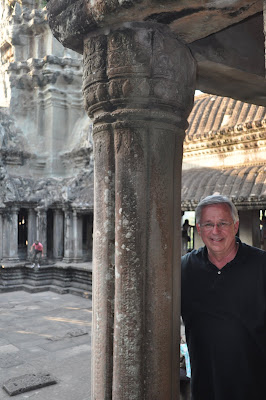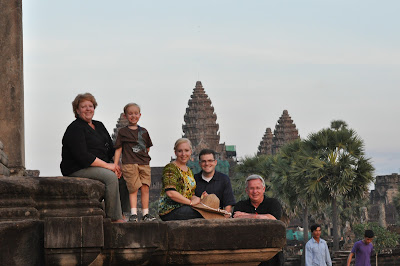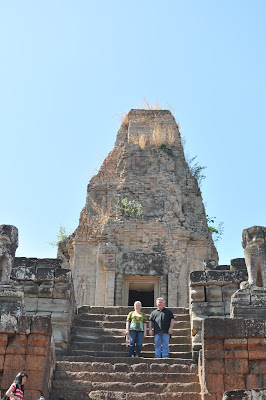We know we have been woefully neglecting our blog! We hope you realize that it's because we've been having so much fun doing things, that we haven't had time to blog about them. But we will be doing a flurry of blogposts this week to get all caught up and everyone updated. I think we left our last blogpost right about Christmas Eve. Look at where we went Christmas Day!
While Jennifer's parents were here for Christmas, we took a trip to visit the Angkor ruins near Siem Reap, Cambodia. The trip was so stunning in so many ways that this blog post won't do it justice.
This is all of us in front of the main attraction - Angkor Wat. This is the largest religious monument in the world, and was once the center of the most powerful civilization in Southeast Asia. I think a brief history lesson is required to fully appreciate what we saw. In the 1100's, a the largest empire in this region of the world was the Khmer empire. The center of the empire was the city of Angkor. The civilization thrived becuase they had learned to grow four crops of rice per year (as opposed to two or three). In those days, rice was money, so they were really really rich, and built lots of religous monuments and temples. The towers in Angkor Wat pictured above were once clad in gold. Around 1400, the Khmer empire lost its power and was conquered by the Siamese (Thailand). At that point the temples were looted and the jungle grew up around them, essentially hiding the ruins until the were "discovered" by European explorers in the late 1800's. Extensive restoration efforts have been carried out by a variety of other countries since the late 1990's, and many of the monuments are remarkably well preserved.
One of the recurring themes at Angkor Wat is Naga, the seven-headed snake. This snake is everywhere. All of the bannisters are actually snakes. All of the roof lines have snakes. The roof tiles are all snakes. Our hotel had a Naga in front of it. Naga is from Hinduism, and is the protector of the milk of eternal life.
Orginally built as a Hindu temple, Angkor Wat is now an active Buddist temple. Here is Craig standing in the outer courtyard with some Buddist monks. Craig is trying to pay his respects to the monks by putting his hands in a prayer position, what a cutie! As a side note, they asked to take a picture with him, not the other way around. We just couldn't resist taking one of our own. Just to give you an idea of how big Angkor Wat is, we are past the main gates. There are still two more courtyards before you are near the five main towers you see.
Here is Craig standing by another statue of Naga. You can see the banister behind him, it is all carved as snake skin.
 Here we are in a corridor on the first floor of the main part of Angkor Wat, past the gates and through the gigantic courtyards. Traditionally, you would enter on the main floor of the temple and walk all the way around starting from the left before entering any further. Along the wall are murals depicting different stories of the Hindu faith as well as stories of the people who lived during the Khmer empire. Below is a Mural.
Here we are in a corridor on the first floor of the main part of Angkor Wat, past the gates and through the gigantic courtyards. Traditionally, you would enter on the main floor of the temple and walk all the way around starting from the left before entering any further. Along the wall are murals depicting different stories of the Hindu faith as well as stories of the people who lived during the Khmer empire. Below is a Mural. With Angkor Wat, each level was viewed as a rising ascension to heaven, and so are three different levels. Here are Craig and RaNae on the steps leading to the middle level. Such a sweet couple! Still smiling and having a good time after 36 years of marriage!
With Angkor Wat, each level was viewed as a rising ascension to heaven, and so are three different levels. Here are Craig and RaNae on the steps leading to the middle level. Such a sweet couple! Still smiling and having a good time after 36 years of marriage! Craig, Jennifer and I climbed the incredibly steep steps to heaven and left RaNae and little Craig to rest on the second level (children aren't allowed up the steep stairs). We were rewarded with an amazing view from the top.
Craig, Jennifer and I climbed the incredibly steep steps to heaven and left RaNae and little Craig to rest on the second level (children aren't allowed up the steep stairs). We were rewarded with an amazing view from the top. Here is Craig (Sr.) at the top in front of a beautiful courtyard - it was well worth the climb!
Here is Craig (Sr.) at the top in front of a beautiful courtyard - it was well worth the climb! We absolutely loved our day at Angkor Wat, but Angkor Wat is just one of the many temples in this compound. Wat is the Khmer (and Thai, too) word for Temple, and we just had to keep exploring!
We absolutely loved our day at Angkor Wat, but Angkor Wat is just one of the many temples in this compound. Wat is the Khmer (and Thai, too) word for Temple, and we just had to keep exploring!Angkor Thom is the former capital city of the Khmer empire. It's surrounded by a massive wall, with finely sculptured gates at each compass point. The gate has a giant carving of Budda (or the King, depending on who you ask) with four faces looking in each direction. There is a giant Naga sculpture leading up to the gate. On the left side of this picture are the "good" guys, and on the right are the demons. Both the good guys and the demons are required for balance - a Hindu take on yin and yang.
Now we are on to another Temple! This one is called Ta Prohm, and it should look familiar! Does it look familiar yet?
Now we are on to another Temple! This one is called Ta Prohm, and it should look familiar! Does it look familiar yet?
The jungle is filled with ancient temple ruins. This is the "jungle temple", which you may recognize from popular Hollywood movies. This was originally a university that the Khmer king converted to a monument to his mother. This temple has fallen victim to the encroaching jungle. The trees have systematically dismantled. the ruins stone by stone. Some of the ruins have been renovated.
Here we all are in one of the courtyards of the temple. You can see the giant roots of a tree that has grown up in the stone. You can also see a dancing diva carved into the wall above RaNae. Almost every inch of the ruins have some sort of carving on them. We'll show you a few more familiar sites: Certainly you will recognize this, it's in Lara Croft, Tomb Raider:
Certainly you will recognize this, it's in Lara Croft, Tomb Raider: WOW! This was such an awe inspiring day, and can you believe we still saw more?
WOW! This was such an awe inspiring day, and can you believe we still saw more?The Bayon is the main temple within the gates of Angkor Thom. It has 40 towers, one tower for each province in the Khmer empire. The towers have four faces carved into them, one facing each direction.
We toured the perimeter of the temple in classic Khmer style - atop our own elephant. Craig and RaNae's elephant "driver" serenaded them with tunes played on a leaf. Click here to see the video of a local Cambodian music group featuring a leaf playing musician.
The faces are all huge. There is some dispute on who the face is. Some say it is Buddha, and that each face represents one of the four virtues of Buddism. Others maintain it is King Jayavarman VII, and he's making a statement that he rules over everything he can see. We all agree that it's spectacular.
This is the "ladies temple," or Banteay Srei. It's much older than most of the area's temples, it dates back to 967 AD. Banteay Srei is made out of a different type of stone. This stone is reddish in color, and is harder, allowing for more intricate carvings. This temple is dedicated to the god Shiva.
Craig and I are standing in front of one of the smaller buildings. You can see the carvings in the background. This temple had a series of courtyards, and we could get into all but the final one.
 Here is one of the intricate carvings over a doorway we found very interesing. It tells the story of the waters being seperated into a higher and lower water.
Here is one of the intricate carvings over a doorway we found very interesing. It tells the story of the waters being seperated into a higher and lower water. The carving over a different door depicts the day when the demon god will be banished for 1000 years.
The carving over a different door depicts the day when the demon god will be banished for 1000 years.This next ruin isn't a temple, but a crematorium built in honor of the King's dad. Jennifer and Craig scaled the steep stairs leading to the top of the center tower. In each of these monuments the towers represent the sacred mountains where the gods live.
Most of the buildings in Angkor were made out of large stone blocks. This one was made out of bricks. However, it still had carvings and reliefs build on top of the bricks.
We got the chance to visit some of the local Cambodians between sites. Craig won them over by sharing his candy with them. They live in houses on stilts so that they don't flood during the rainy seasons.
Rice growing is still a major activity. Here is a group of local farmers harvesting the rice. Once it's harvested, they will lay it in the sun for two days to dry.
After the rice has dried, farmers use their water buffalo to trample the rice in order to separate it from the rest of the plant. This is why everyone's got a water buffalo (yours is fast but mine is slow).
Another crop that is grown in Cambodia is lotus blossoms. Lotus blossoms have special significance in Buddhism, as Buddha walked on seven of them as a child. They actually have a fruit in them which is used in making food such as mooncakes (soo yummee!)
We also visited the floating villages built on tributaries to Tonle Sap, the largest freshwater lake in Southeast Asia. Behind Jennifer are houses, schools, churches, and markets, all floating on the river.


Here is a typical house on the floating village.
 Isn't this inventive?! This is how kids paddle themselves to and from school and to their friends floating houses. In big pots!
Isn't this inventive?! This is how kids paddle themselves to and from school and to their friends floating houses. In big pots! We couldn't believe our eyes when we saw this boy floating by on a boat. Did you ever think we'd see a 2 year old playing with a huge snake? I guess everyone needs a pet. Although, come to think of it, I don't. And certainly not a snake!
We couldn't believe our eyes when we saw this boy floating by on a boat. Did you ever think we'd see a 2 year old playing with a huge snake? I guess everyone needs a pet. Although, come to think of it, I don't. And certainly not a snake!Of course, no trip is complete without dinner and dancing. We let the Cambodians do the dancing, though. Click here to see the video.
We had an incredible time in Cambodia. We were also thrilled to have Craig and RaNae join us to share the experience with. Our trip to Angkor Wat is one of the most memorable sites we've seen, and stands out as a wonderful place full of culture and history. We barely scratched the surface of all this area has to offer.






































